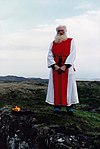Allsherjargoði (Ásatrúarfélagið)

The allsherjargoði (Icelandic pronunciation: [ˈalsˌhɛrjarˌkɔðɪ]; plural -goðar) is the chief religious official of the Icelandic neopagan organization Ásatrúarfélagið in Iceland. Office holders are elected.
Historical background
[edit]The title is a modern adoption of the medieval political title allsherjargoði which was in use during the Icelandic Commonwealth from 930 to 1262. A goði was a local political leader, and allsherjargoði can be translated as "all-people chieftain". The original title was held by the goði who held the goðorð (an administrative division) of the descendants of Ingólfr Arnarson, the first settler of Iceland. The role of the allsherjargoði was to sanctify the Althing as it began every year.[1]
Elections
[edit]When Ásatrúarfélagið was founded in 1972, this historical Icelandic title was chosen for the chief official of the organization. Shortly after establishing the organization on the First Day of Summer of 1972, the founding members chose the poet and farmer Sveinbjörn Beinteinsson as the first holder of the title.[2]
Sveinbjörn remained in office until his death in 1993. An election for a new allsherjargoði was then held in 1994. The two candidates were the founding member Jörmundur Ingi Hansen, who ran on a platform of continuity, and the artist Haukur Halldórsson, who promised more innovation. Jörmundur Ingi won with 59 votes against 34; one vote was blank.[3]
In 2002, dissatisfaction with Jörmundur Ingi's way of running the organization resulted in his removal from office and he was replaced by Jónína Kristín Berg as a temporary allsherjargoði. A regular election was held the following year and the musician Hilmar Örn Hilmarsson was chosen, with Jörmundur Ingi's approval.[4][5]
List of allsherjargoðar
[edit]| Image | From | To | Name |
|---|---|---|---|
 |
1972 | 1993 | Sveinbjörn Beinteinsson |
 |
1994 | 2002 | Jörmundur Ingi Hansen[6] |
| 2002 | 2003 | Jónína Kristín Berg[7] | |
 |
2003 | Hilmar Örn Hilmarsson |
References
[edit]- ^ Gunnar Karlsson, Goðamenning. Investigation of the role of the goðar (chieftains) in the Old Commonwealth period. ISBN 9979-3-2553-4. ISK 4990. (2004)
- ^ Sveinbjörn Beinteinsson and Berglind Gunnarsdóttir. Allsherjargoðinn. Hörpuútgáfan, 1992. p. 132. ISBN 9979-50-025-5
- ^ Ásatrúarfélagið Jörmundur Ingi allsherjargoði. 25 May 1994. Morgunblaðið.
- ^ Stefanie von Schnurbein. 2016. Norse Revival: Transformations of Germanic Neopaganism. Brill Publishers. p. 69
- ^ Yfirlýsing frá Lögréttu. 25 August 2002. Morgunblaðið.
- ^ "Hyggst gera ásatrúna sýnilegri almenningi". DV, May 24, 1994, page 6. Available online at http://timarit.is/view_page_init.jsp?pageId=2626657&issId=195406&lang=en
- ^ Jónas Þ. Sigurðsson. "Yfirlýsing frá Lögréttu". Morgunblaðið, August 25, 2002, page 16. Available online at http://timarit.is/view_page_init.jsp?pageId=3451577&issId=250831&lang=en
External links
[edit]- Ásatrúarfélagið's presentations of the allsherjargoðar Archived 2018-06-24 at the Wayback Machine
